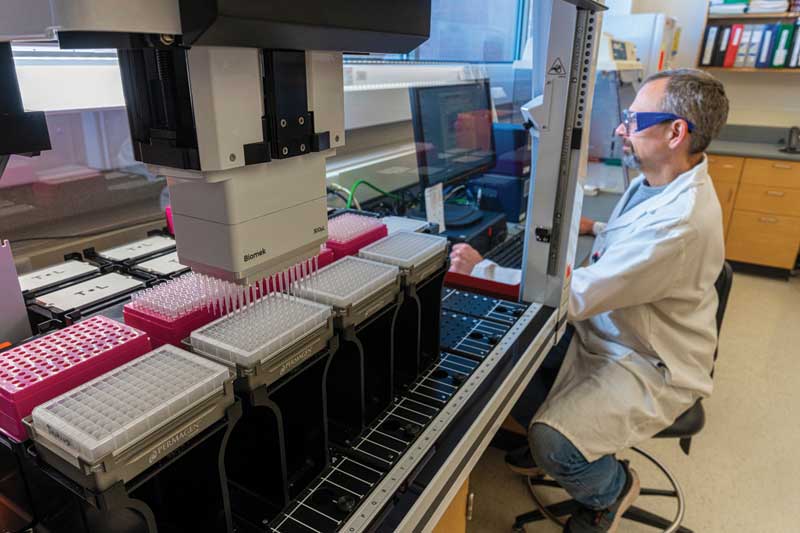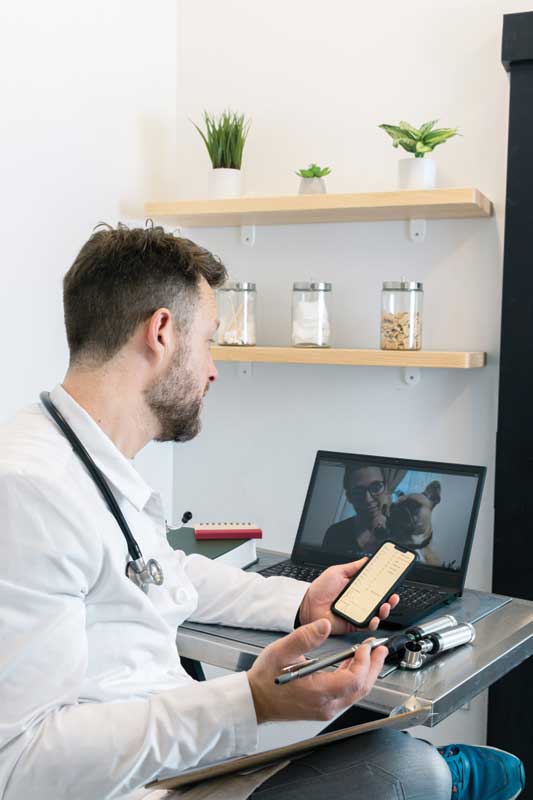
There have been so many advancements in diagnostics in the veterinary field in recent years that one would be hard pressed to point out one outstanding benefit over others. Indeed, convenience, improved outcomes, and better patient care are chief among the benefits of these new technologies, which seem to be emerging yearly. Advances in equipment, software, 5G, and artificial intelligence, were just a few “must-watch” areas pushing diagnostics.
Improved capabilities to better diagnose and then treat patients are only matched by the ability to more efficiently do so for Keith Poulsen, DVM PhD, DACVIM, director of the Wisconsin Veterinary Diagnostic Laboratory.
“We do a lot of bovine PCR panels at the Wisconsin lab, and as the number of tests increased, they became cheaper because we were saving on reagents and plastics,” says Dr. Poulsen, who is also president of the American Association of Veterinary Laboratory Diagnosticians (AAVLD). “The technologies and platforms continue to improve to be more efficient so we can offer them on a more daily basis.”
Catherine Cole, DVM, with West Concord Animal Clinic in West Concord in Massachusetts, regularly makes use of antigen testing.
“Parasite shedding cycles, as well as limitations in traditional fecal floats, used to make ruling out parasites more of a gray zone,” says Dr. Cole. “Now I can treat definitively, knowing that a parasitic infection will be accurately identified.”
In-house
So called “in-house” options for Dr. Cole, who is also an adjunct clinical professional for the Cummings School of Veterinary Medicine at Tufts, include CRP, which she considers a “valuable tool” to assess severity of disease.
“I also appreciate being able to quickly run diagnostics prior to refilling medications, which is both profitable for the practice and beneficial to the pet parent as they can walk out the door with a new dose in hand if needed,” Cole adds.
Screening tests are at the forefront of what she does almost daily, which she says enables practitioners like her to “cast a wider net” to catch these deadly diseases before they become clinically apparent, and potentially more advanced and difficult to treat.
“I definitely see more screening tests becoming available, as well as advances in genetic testing,” Cole says. “We’ve come a long way in the human world, and it only stands to reason the veterinary world will follow suit.”
Automation and next gen
Poulsen believes the next big leap in diagnostic efficiency is the movement towards automation and smaller reaction volumes in a 384 well PCR plate format. Most PCR assays are currently completed in a 96 well plate, he says.
“So, what that does is it allows us to be much more efficient by using fewer reagents and four times as many samples per plate or run,” Poulsen says.
“This format really caught on with COVID because running a 384-well platform was needed for the millions of tests collected. We need automated liquid handling robots to set up the 384 well plates because the wells are tiny and not able to be filled by hand.”
Poulsen believes more of the industry’s research and development for the future of diagnostic testing will be done with metagenomics and next generation sequencing technologies, for example, that laboratories are using to help manage the highly pathogenic avian influenza outbreak that started in 2022.
Knowing the sequences and lineages of viruses are critical in his view to enable experts to help track where and how the virus is spreading and to monitor for genetic changes.
“So, we can sequence a sample in a matter of hours now, but I think the future will be in mainstream use of metagenomic technologies. In a metagenomic analysis, all genomic material in a sample is sequenced, not just specific targets,” Poulsen says.
“The sequence and amplification part of the science is actually pretty straightforward, but what’s holding the method back isn’t necessarily amplification of all of the of the DNA and RNA, it’s actually what we call bioinformatic analysis.”
He adds: “Bioinformatics’ role is to make sense of all that As, Ts, Cs, Gs, and Us in the DNA and RNA.”
5G and telemedicine
The sheer power of new technology is emerging to get images and information out faster and in greater detail to practitioners and specialists are among the advancements in diagnostics J.K. Waldsmith, DVM, believes are most important. He sees 5G technology alone as one of the key developments that
will push telemedicine to the next level.
“With the availability of 5G internet speed and access improving, and the accommodation of state veterinary practice acts, telemedicine is becoming more of a reality,” says Dr. Waldsmith, president of Vetel Diagnostics in San Luis Obispo, CA.
How the services are rendered, and the prerequisite veterinary-client-patient-relationships (VCPR) vary by state. “However, where allowed, telemedicine can improve accessibility to patient care for animal owners, and earlier intervention can potentially improve patient outcomes,” Waldsmith adds.
The continued development of these technologies will require not only a change in mindset from practitioners, but possibly a change in business models.
“Veterinary practitioners will have to overcome decades of giving away medical advice and incorporate fees and time allocation to deploy telemedicine services in their practices,” Waldsmith says.
He also suggests those shifts should include practitioners considering embracing another benefit of the 5G internet environment: teleconsulting.
“This is especially evident in diagnostic ultrasound in that many practitioners are not confident in using this diagnostic modality based on a lack of training and experience,” Waldsmith says. “With advances in diagnostic ultrasound technology that utilize web interfaces it is now possible for practitioners to perform their own ultrasound exams in-clinic while receiving real-time consultation from ultrasound experts. This helps to improve patient outcomes by the more immediate availability of ultrasound-aided diagnostics performed in-clinic vs. referral to outside experts.”
Big data
A caveat to any big data that produces so much and such a vast array of information is the amount of work required for end-users to understand the data and to be able to utilize it effectively.
An example Poulsen used is determining what really is a pathogen compared to host genetic material or normal flora. For now, end-users can take the new sequence information and compare it to known sequences to see if it’s a new virus, for example.
“Or, if a virus evolves or mutates, such as in 2015 with a new strain of canine influenza that came to the U.S. from infected dogs in Asia, metagenomics and whole genome sequencing can be used to design a PCR assay tailored to the new viral strain, but one is significantly faster and cheaper,” Poulsen adds.
He sees a near future in which this information and the work being done now will put practitioners and the veterinary industry in better position to deal with newly emerging viruses.
“I do think hopefully in the next five to 10 years, we might even move away from PCR and go more towards just metagenomic analysis of all samples to give the submitting veterinarian significantly more information of what genetic material is in a sample from a sick animal,” Dr. Poulsen says. “To do this, the cost to the veterinarian needs to be what a PCR panel is now, about $130 to $150, and the data analysis will need to be automated.”

Advancements
The most-discussed technology of today is artificial intelligence, and Dr. Waldsmith views the possibilities and promise of AI to transform and aid veterinary medicine and practitioners are particularly noteworthy in diagnostics.
“Based on improvements in the core imaging technologies themselves, web-based access, and the promise of AI, the quality and efficiency of medicine will improve, and patients will have better lives–so long as these services can be afforded by the animal owner, which is the subject for another day,” Waldsmith says.
He also believes caution is warranted with the adoption of AI. Much of the media coverage and talk around AI development has been about the technology displacing workers, taking over key tasks that should be left to humans, or becoming malevolent. However, Waldsmith warns more immediate problems for practitioners and the field of veterinary medicine could be from people taking shortcuts or from companies over-hyping the technology.
“Any student of game theory knows the first thing rewarded in a new game is cheating,” he says. “Veterinary medicine, with its lack of regulation and scrutiny, at least when compared to human medicine, makes it ripe for abuse when it comes to promises of an AI-based utility. It will be important that practitioners have some understanding of AI and neural networks to help assess if the promise of an AI-based product is likely to be effective.”
That is one reason Dr. Waldsmith advises skepticism about any AI platform that promises a diagnosis.
“AI should be seen as an extremely fast and unbiased assistant that helps you identify that which is not normal,” he says. “Said another way, AI is really good at finding needles in haystacks. The practitioner then needs to assess the significance of what the AI platform indicates is not normal in the context of the clinical presentation and the practitioner’s experience.”
Whether it is AI or new equipment, Cole is encouraged by the pace of advancements.
“I feel like I’m reading about something new every week and it’s exciting to see what we now have at our fingertips,” he says. “It’s a really good time to be a veterinarian in terms of what we can now do for our patients.”
Don Jergler has been a reporter for more than 25 years, covering insurance, real estate, and other topics. He spent two decades as a reporter at several daily newspapers, then entered business-to-business reporting. Jergler is currently the Western Region editor of Insurance Journal and editor of Claims Journal.
